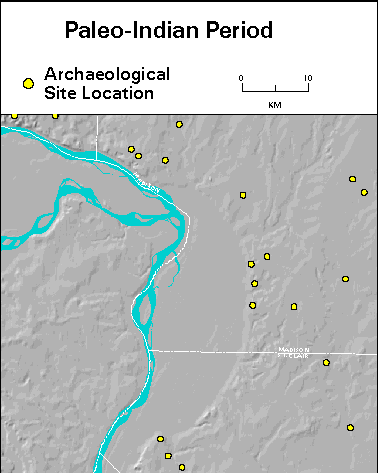| Environment | Technology | Settlement | Economy | Society | Health | Religion | |
| How-Do-We-Know? | |||||||
| Paleo-Indian | Archaic | Woodland | Mississippian | European Contact |

Most of these isolated finds of Clovis points are from the uplands. They are typically situated on ridges or bluffs overlooking valleys. One explanation for this distribution is that ridges and bluffs overlooking valleys afforded Clovis hunters easy access to big game animals below as well as the plants and animals in the somewhat drier uplands.
While occasional torrents of water from melting glaciers to the north probably made living in the Mississippi risky, it is more likely that the lack of Clovis points in the American Bottom is due to the fact that Pleistocene surfaces on which Clovis people lived have either been eroded from the valley, or lie deeply buried below 10,000 years of sedimentation.
The one stratified Clovis site from the midwest, Kimmswick, is located on a small tributary of the Mississippi River in Missouri just opposite the American Bottom. At Kimmswick several Clovis points and other stone tools such as scrapers, point preforms, and gravers were found with the bones of extinct Pleistocene animals including mastodon, ground sloth, and peccary. Geological analyses have shown that the site formed in and on the edges of a backwater lake adjacent to a nearby small stream. The presence of a sulfur spring at one edge of the terrace probably attracted many large animals to the site, which in turn attracted the Paleo-Indian big game hunters.
Thus, the distribution of Paleo-Indian sites in the American Bottoms indicates that these hunters and gatherers living in a glacial environment made very clear choices of where to live. Proximity to diverse plant and animal resources was obviously the primary consideration. Camping spots were located in places where both big game animals could be observed from a distance and other resources were abundant. Big game may have been hunted at places where large animals often congregated such as watering holes and mineral springs.
| Paleo-Indian | Archaic | Woodland | Mississippian | European Contact |